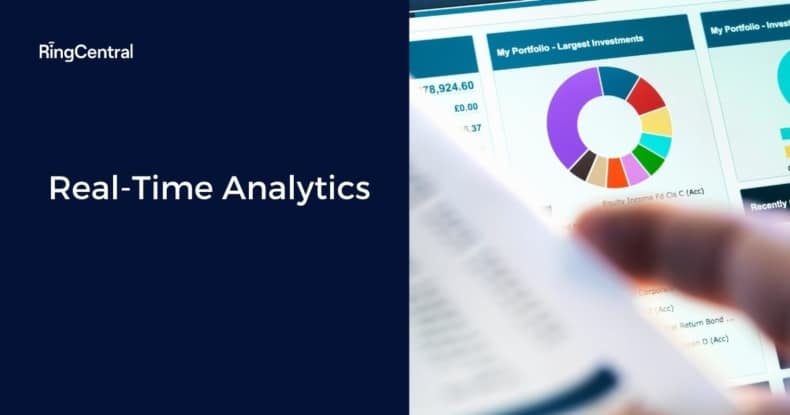In this article, we'll cover:
What is Real-Time Analytics? Benefits, Impacts and Examples

Any business that operates online, or offline for that matter, relies on data to not only monitor performance, but to give informed insights that influence important decisions about how the business will operate in the future. The decisions you make based on any particular data sets can have a huge impact on the direction your business takes.
While some historical data will always be important, there are many times when you need to know what is happening in the “now”. How certain aspects of your business are working, and if there are any issues that need to be dealt with. With so many terabytes of data flowing across the IoT (internet of things), how can you possibly track it all?
There are many types of businesses who rely on real time analytics in their day-to-day operations in order to work efficiently and who may struggle without access to immediate data.
Businesses such as call centres need call tracking and analytics to operate at peak efficiency, for example. So, just what is real-time analytics? How does it work and what benefits can using this big data offer?
Let’s find out.
What is Real-Time Analytics?
Put simply, real time analytics refers to real time processing of data where you can prepare, measure, and analyse new data as it enters your system or database.
This allows business owners, managers, supervisors, and even staff to get almost instantaneous insights into what is happening in the business from wide ranging data integration.
Real time streaming analytics enables a business to react to any sort of situation without the delays associated with batch-style analyses. Having insights when it’s too late to solve a particular issue can be costly in a modern digital business world where having business intelligence (BI) in the here and now is a major competitive advantage.
How Does Real Time Analytics Work?

In essence, any sort of data analytics operates by pulling or pushing large amounts of data into your system. To get that big data into your system, and ready for analysis, there is usually some method for streaming data in place. In some scenarios, that streaming may utilise a lot of resources and may not be ideal for your needs.
As an alternative, you can customise your system to pull in the required data at different intervals. According to your needs, and the amount of data in question, those intervals could be anywhere from a millisecond to several hours. For accurate real time analytics, those intervals are more likely to be seconds than minutes, however.
To work properly, the software you use for analytics will contain some or all of the following components:
Aggregator
This is the component that pulls and compiles your real time data from the various data sources.
Broker
The broker makes the data available to use in real time.
Analytics Engine
This component is your driving force. It compares and correlates the values of your data streams and analyses it.
Other Technologies
There are various other components and technologies that contribute to the process. A stream processor executes logic and performs real time analytics by sending and receiving your data. Other technologies include in-memory analytics, processing in memory (PIM), in-database analytics, and massively parallel programming (MPP).
Benefits of Real-Time Data
Why should you choose real time analytics over batch analytics?
By switching to analysis in real time, you can boost the productivity and efficiency of your organisation, as well as reducing risk, lowering your costs, and gaining more detailed insights into your business, your customers, your employees, and the financial health and future directions of your company.
Data visualisation
If you use historical or batch data, then you are getting a snapshot of a past event. With real time data, you get visualisations of how changes are occurring as they happen.
Think of it like a football manager watching a game and making changes as and when he sees them needed. Your dashboard is giving you a live and interactive view, and one that you can share with other stakeholders.
Ability to Track Customer Data
With real time analytics, you can track changes and trends in customer behaviour as they happen. It can also help you to deliver a more personalised experience and improved response time by seeing how customers are behaving on your site or on your social media platforms.
Cost Efficiencies
Real time big data analytics used to be a complicated process that could involve higher costs. With advanced automated systems, AI, and machine learning developments, though, you have direct access to data as it happens, meaning lower costs on analytical systems.
Increased Speed of Response and Results
If an issue of any type arises, real-time data means you can respond to it almost immediately. It can also help you improve results by making tweaks in real time when needed
Instant Collection of Data for Business Decision-Making
Given you can set the system up so you collect only the data, KPIs, and metrics you need, you see that data instantly, allowing you to make decisions for immediate action as well as future actions.
Testing Capabilities
With instant access to data, you can make changes to various elements of your site and instantly see how those changes affect customer behaviour. That means you can take calculated risks and change back if they have an adverse effect.
Challenges in the Real-Time Analytics Space
IMAGE HERE
Of course, it’s not as simple as just flicking a switch in order to make the change to real time analytics. So, what challenges do you face if making this decision?
Price of Investment
Pricing is always going to be a consideration when you implement new systems or processes, and that holds true if investing in a new analytics platform. What you have to consider is the long-term implications of having access to real time analytics. Improved sales and conversion rates and thus, increased profitability are among the plusses you may see.
It’s worth noting that there are open source options such as Apache Spark and Hadoop available. A savvy DevOps team can adapt these to many of your data processing needs and thus reduce the price of investment.
Accuracy and Expiry of Data
One thing you want to be sure of is the accuracy and lifetime of your data. Given that you may want data usable across your organisation, you need to know that by the time it’s processed, it’s still relevant and accurate. This means that you should always value quality over quantity.
System Architecture
If you want to implement real time analytics, you need data analysis architecture that can process your data at high speeds. However, those speeds can vary according to where the data comes from and what type it is.
The architecture also needs to be scalable so that it can handle any spikes in data volume when needed. You may also want to be capturing both real time and offline data, so your architecture should be able to handle both with no conflict.
Implementation of Tools
As with anything new, you need to consider the process of implementing it into your existing system. You want to avoid any disruption if possible, but you also need to consider that this change is a major paradigm shift for your business. That means you have to look at what adjustments, if any, are needed to your company culture to deal with this new, faster method of real time analysis.
Top Use Cases of Real Time Analytics
IMAGE HERE
People tend to think of analytics tools primarily in terms of how they’re used within online (and offline) retail environments. The reality is that faster analysis of data in real time can offer advantages in many diverse sectors, from an ecommerce supply chain (for example, with Amazon) to healthcare.
IT Security
With the continuing rise in cybercrime, cybersecurity has never been more important. There is little point in noticing a data breach or hack after it’s happened.
Real time analytics lets your IT team monitor how your data is accessed, instantly spot any suspicious activity, and act on those alerts before there is a major issue.
Marketing and Personalisation
Although A/B testing is often used to test the efficiency of a marketing campaign, you have to wait for results. By adding real time analytics to the mix, you can see what is working, or not working, instantly, and make any necessary adjustments. You can also utilise that real time data to add an extra degree of personalisation to your campaigns.
Financial Services
45% of all losses to fraud in the UK in 2020 was due to credit card fraud. Being able to spot unusual or suspicious activity on financial databases is essential in the financial services sector.
Large companies use real time data to flag if a purchase or pattern is unusual, so they can contact the customer to confirm and authorise the transaction.
Operation and Production Activities
In manufacturing, streamlined and efficient workflows are essential for high productivity levels and OEE (Overall Equipment Effectiveness). Real time analytics can help reduce negative effects of silos, increase communication, and assist in operational decision making.
Predictive Maintenance of Systems
Any sort of machinery is prone to wear, tear, and breakdowns. By monitoring relevant data in real time, predictive analytics alerts you when a piece of machinery is likely to be in need of maintenance before it actually breaks down. This not only saves time and money but can also contribute to better health and safety.
Identification and Monitoring of KPIs
Depending on the nature of your business, you’ll rely on different KPIs to monitor performance. Those KPIs may even differ for different departments. Real time analysis of data can help you identify what KPIs matter most and can track any patterns so you can make future plans.
Conclusion
Real time analytics is not for everyone, but if you have a dynamic business that sees lots of daily activity, then it may well be essential. By utilising real time analysis of data, you not only have the potential to boost your organisation’s efficiency and profitability, but also to improve customer experience by being more responsive to issues.
Data processing is an integral part of your business at some level, but real time analytics can improve how you operate, help with latency issues, and ensure you offer high availability of services. In an increasingly competitive world, anything that can give you an edge is worth considering.
Originally published Nov 10, 2021


